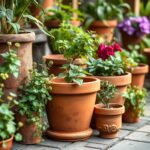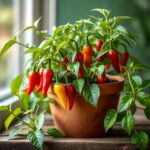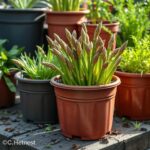What is the Best Thing to Put in the Bottom of Pots for Drainage? Essential Tips for Healthy Plants

When it comes to ensuring the health of your plants, proper drainage is essential. One critical aspect often overlooked is what to place at the bottom of pots to facilitate effective drainage. Choosing the right material helps prevent root rot and promotes robust growth by allowing excess water to escape. In this article, we will explore the best options for pot drainage, examining their benefits and drawbacks. Whether you’re a seasoned gardener or a beginner, these essential tips will help you create a thriving environment for your plants, ensuring they flourish with every season.
What is the Best Thing to Put in the Bottom of Pots for Drainage?
Using the right material at the bottom of pots is crucial for ensuring proper drainage, as it helps prevent overwatering and promotes healthy root growth. The best options include materials like gravel, pebbles, or hydroponic clay pellets, which allow excess water to escape while supporting the plant above. Additionally, some gardeners prefer to use a layer of landscape fabric to separate the soil from the drainage material, preventing soil from clogging the holes in the pot. Ultimately, the choice of drainage material may vary based on the type of plant and the potting soil used, so it's essential to consider the specific needs of your plants.
The Importance of Drainage in Plant Pots
Proper drainage is vital for plant health, as it prevents water from accumulating at the bottom of the pot, which can lead to root rot and other diseases. Without adequate drainage, excess moisture can suffocate roots and inhibit nutrient absorption, causing stress and potentially leading to plant death. Thus, selecting the appropriate material for the bottom of pots is essential to maintain a healthy environment for plant growth.
Best Materials for Drainage
The most commonly used materials for enhancing drainage in pots include gravel, rocks, and expanded clay pellets. These materials are effective because they create air pockets and spaces that allow water to flow freely out of the pot. For instance, gravel is heavy and can effectively weigh down the soil while letting excess water escape. Additionally, expanded clay pellets are lightweight and excellent for providing aeration while retaining some moisture, making them a flexible choice for many types of potting applications.
How to Layer Your Drainage Material
When layering your drainage material at the bottom of a pot, it's best to start with a 1-2 inch layer of your chosen material, such as pebbles or gravel. Place this layer directly under the potting soil, considering using a piece of landscape fabric above it to prevent the soil from slipping through the drainage layer. This technique helps maintain sufficient aeration while safeguarding the drainage material's effectiveness, ensuring that water can flow freely and preventing soil compaction.
How Drainage Affects Soil Composition
The type of drainage material you choose can also influence the overall composition of the soil within the pot. For example, using large rocks may hinder soil from compacting, whereas smaller materials like sand or finer gravel can provide more stability. Additionally, the proportion of organic materials in the soil will determine how quickly it retains moisture; thus, ensuring that your drainage choices complement your soil mix becomes key to promoting optimal growth conditions for your plants.
See also:
Common Myths About Pot Drainage
One common myth is that placing a layer of stones at the bottom of a pot is sufficient for drainage. In reality, while stones can help, they may not be as effective as other materials like perlite or expanded clay. Another misconception is that adding multiple drainage holes ensures better drainage; however, it is essential to combine proper materials with appropriate pot size and soil composition for a truly efficient drainage system. Understanding these myths allows gardeners to make informed decisions about plant care.
| Material | Advantages | Disadvantages |
|---|---|---|
| Gravel | Excellent for weight and stability | Can be difficult to remove when changing plants |
| Pebbles | Great aeration and drainage | May not retain moisture adequately |
| Expanded clay pellets | Lightweight and suitable for various plants | Can be more expensive than other options |
| Sand | Inexpensive and readily available | Can compact over time |
| Landscape fabric | Prevents soil from clogging holes | May deteriorate with prolonged use |
Should you put rocks in the bottom of plant pots?

When it comes to the practice of placing rocks at the bottom of plant pots, opinions vary among gardeners and horticulturists. Traditionally, many people have believed that adding rocks helps improve drainage. However, recent studies and expert opinions suggest that this may not be as beneficial as once thought.
Understanding Soil Drainage
Soil drainage is crucial for the health of plants, preventing root rot and facilitating aeration. Proper drainage allows excess water to escape while retaining moisture necessary for plant growth. Instead of rocks, it is often recommended to focus on the soil mix to ensure appropriate drainage.
- Soil composition significantly influences drainage capabilities.
- Using materials like perlite or coco coir can enhance drainage without taking up valuable space.
- Hydration levels can be maintained by adjusting the type of potting mix used.
The Myth of Rocks for Drainage
The longstanding belief that rocks improve drainage by providing a layer to prevent water from pooling at the bottom of the pot is a myth. In reality, rocks can create a situation where water remains above the drainage hole, slowing down the escape of excess moisture.
- The size of the rocks does not correlate directly with improved drainage.
- A layer of rocks might create a perched water table, leading to over-saturation of the soil above.
- Rocks take up space that could be better used for soil, which is essential for nutrient retention and plant health.
Alternative Methods for Improved Drainage
Instead of using rocks, there are more effective methods to ensure that your plants have adequate drainage. Utilizing high-quality potting soil and implementing proper watering techniques can vastly improve plant health.
See also:
- Choose a well-draining potting mix designed for the specific type of plant.
- Consider using pots with built-in drainage layers or self-watering systems.
- Create a drainage layer at the bottom using materials specifically designed for this purpose, like gravel or ceramic pellets.
Benefits of Proper Potting Techniques
Using proper potting techniques not only enhances drainage but also supports the overall health of the plant. When the soil can drain well, it leads to a more stable environment for the roots, fostering growth and resilience.
- Improved root development due to better oxygen availability.
- Less likelihood of plant diseases associated with overwatering.
- Enhanced nutrient absorption resulting from a balanced soil environment.
When Rocks Might Be Useful
Although rocks might not be ideal for drainage, they can serve other purposes in gardening. Understanding these alternative uses can help in effective garden management.
- Rocks can be decorative, adding aesthetic value to your potted plants.
- In some cases, rocks can help maintain heat in the soil for specific plants that thrive in warmer conditions.
- They may serve to weigh down larger pots or outdoor containers to prevent tipping over.
Questions from Our Readers
What materials are best for drainage at the bottom of pots?
Gravel, small stones, or pottery shards are commonly recommended for use at the bottom of pots because they allow water to flow through easily while preventing soil from clogging the drainage holes.
Should I use rocks instead of potting soil for drainage?
Using rocks can be beneficial for drainage, but it's important to maintain a balance with potting soil so that your plants can still draw nutrients; you might consider using a combination of both.
How much drainage material should I put in the bottom of the pot?
A layer of about 1 to 2 inches of drainage material is often sufficient to promote proper water flow without taking up too much valuable space that could be filled with soil.
Can I use recycled materials for pot drainage?
Yes, using recycled materials such as broken ceramic pieces, old bricks, or even crushed cans can be effective for drainage, provided they allow water to escape while keeping the soil contained.
See also:

If you want to read more articles like What is the Best Thing to Put in the Bottom of Pots for Drainage? Essential Tips for Healthy Plants, we recommend you check out our Pots category.
Leave a Reply
Related Articles